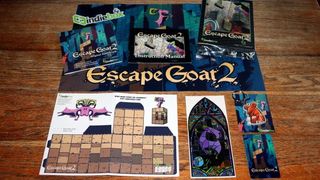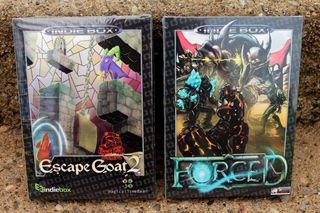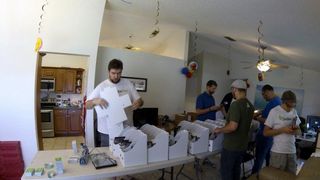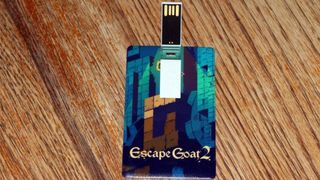Inside IndieBox, the startup bringing back the glory of 80s game packaging

Consider the box. There was a time when the lowly construct of cardboard was more ubiquitous than Steam: If you wanted a game, you bought it in a box, complete with manual, reference card, promotional material for other games in the publisher's catalog, and, in many cases, “the stuff”: Supplemental reading material, perhaps, or a swanky poster, or a microscopic alien space fleet in a ziplock bag. And it was good. Browsing row upon row of brightly colored boxes of various sizes and shapes was exciting not just because you knew you'd be coming home with something, but because you could never be entirely certain what was inside. That mystery is an element of the game-buying experience that's just not possible with the "all things at all times" nature of digital distribution, and for some gamers that's a real loss.
IndieBox hopes to fill that void with a unique blind subscription service: an indie game delivered to your mailbox every month, along with specially crafted box art, a manual, and other goodies. You never know what you're going to get: You pays your dime, as they say, and you takes your chances. It is perhaps an odd way to do business, but as co-founder John Carter explained, there's an odd kind of sense to it, too.
The IndieBox works on two levels. The package itself is a DRM-free "collector's edition" of a hit indie game— Teslagrad , Escape Goat 2 and Forced so far—with soundtrack CDs, papercraft, posters, and other tchotchkes. The "mystery" is that the box sold via monthly subscription, but each month's title is kept secret until it ships. It's possible to buy the games after the fact if you're really hung up on knowing what you're paying for, but the price is considerably higher than the monthly subscription rate, which runs from $15 to $18 a month , plus shipping, depending the length of the subscription term—and it may be out of stock.
"The original idea was that it's kind of a 'book of the month' club, but for indie games," Carter said. "We want to build the reputation that you don't need to know the game we're giving you for you to enjoy it—like that one friend in high school who knew all the cool games. All you needed to hear from him or her was, 'Hey, have you heard of X game?' and you'd already be sold. They were the tastemakers of the day."
IndieBox releases are very polished and professional, so I was surprised to learn that it's all handled by a three-man operation—Carter, who handles partnerships and press; Jason Blank, the lead developer; and James Morgan, the president, who takes care of everything the other two don't—backed up by a "small team of volunteers." They work out of their homes, keeping in touch online with applications like Slack and Google Hangouts, and so it's not entirely surprising that it was difficult, at first, to get developers on board.

"We originally brainstormed indie games that we'd love to work with and then just started doing cold calling. When we were just starting out developers were interested but nervous we might be vaporware or a scam. We didn't have a product to showcase yet, so we didn't take offense," Carter said. "We still consider ourselves very lucky that [Teslagrad developer] Rain Games was so interested in working with us. Since we've been able to 'prove ourselves,' studios have been much more receptive to cold calls and have started reaching out to us."
The process of designing each box involves more "brainstorming" about how to best represent that month's game, with approval for almost everything coming from the original developers. Some elements, like the soundtrack and poster, will always "more than likely be there," while other bits, like the molded mouse keychain in Escape Goat 2, will change from box to box.
The biggest gaming news, reviews and hardware deals
Keep up to date with the most important stories and the best deals, as picked by the PC Gamer team.
"The manufacturing team focuses on what fun contents they can include in the box, while the design team gets to work on designing the box and manual. While all game assets are provided by the studio, we (so far) have done all the designing. We sometimes partner up with great creative people like Cubeecraft , who designs all our papercraft for us," Carter explained. "Meanwhile, the manufacturing team is brainstorming the perfect contents, pricing them as low as they can, and reaching out to manufacturers. Both the manufacturing and design brainstorming are a team effort, however—we ask everyone else on the IndieBox team to give us insight. You never know where a good idea is going to come from."

Specific creators vary from box to box. "The first two boxes had original box art. Teslagrad was done by Dan Jones and Escape Goat 2 by Kailyn Boehm . It's one of our goals to work with independent artists to showcase their art and reimagine these great games," Carter said.
His earlier references to separate design and manufacturing “teams" make the operation sound almost industrial, but the truth is that each one is composed of two people, a "director" and a volunteer, and the boxes are assembled and prepared for shipment at what Carter described as "packing parties."
"We each invite a few friends, provide food, caffeine, and a copy of the box for their hard work. Each month we need more friends to come out to help out," he said. "We're looking forward to paying them sooner than later, though! We do all the assembly, from packing to sealing to boxing to shipping."

Will it last? Can it last? Digital distribution is ascendant, and no matter how good IndieBox's final product may be, its long-term success will be reliant on the ongoing demand for a type of product that, by most assessments, is in the midst of a long, slow and inexorable death spiral. And unlike the boxes of old, it can't even get lucky with the occasional bored shopper at GameStop; it is targeted almost exclusively at the demographic that's most keenly aware of the advantages of digital. It's a seriously tough sell, but Carter is optimistic.
"It's an impressive trajectory for a small company with next to no marketing budget (yet) and once we start making it out to events like GDC, E3, and PAX, I feel that we're going to get some big exposure that will come with high subscription numbers," he said. "The game industry as a whole may be shifting to a digital direction and I don't see that slowing down, but there will still be that demand for high quality physical products, and we're looking to keep filling that niche. In fact, as the shift to digital increases, that only gives us a larger market to cater to!"

Andy has been gaming on PCs from the very beginning, starting as a youngster with text adventures and primitive action games on a cassette-based TRS80. From there he graduated to the glory days of Sierra Online adventures and Microprose sims, ran a local BBS, learned how to build PCs, and developed a longstanding love of RPGs, immersive sims, and shooters. He began writing videogame news in 2007 for The Escapist and somehow managed to avoid getting fired until 2014, when he joined the storied ranks of PC Gamer. He covers all aspects of the industry, from new game announcements and patch notes to legal disputes, Twitch beefs, esports, and Henry Cavill. Lots of Henry Cavill.
Most Popular







